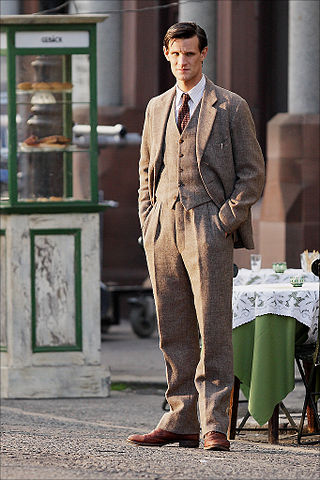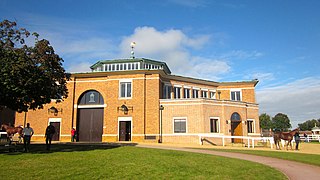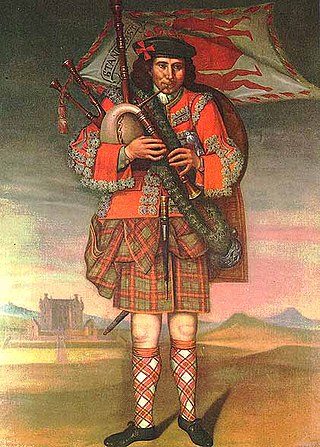
A kilt is a garment resembling a wrap-around knee-length skirt, made of twill-woven worsted wool with heavy pleats at the sides and back and traditionally a tartan pattern. Originating in the Scottish Highland dress for men, it is first recorded in the 16th century as the great kilt, a full-length garment whose upper half could be worn as a cloak. The small kilt or modern kilt emerged in the 18th century, and is essentially the bottom half of the great kilt. Since the 19th century, it has become associated with the wider culture of Scotland, and more broadly with Gaelic or Celtic heritage.

Madras is a lightweight cotton fabric with typically patterned texture and tartan design, used primarily for summer clothing such as pants, shorts, lungi, dresses, and jackets. The fabric takes its name from the former name of the city of Chennai in south India.

A waistcoat or vest is a sleeveless upper-body garment. It is usually worn over a dress shirt and necktie and below a coat as a part of most men's formal wear. It is also sported as the third piece in the traditional three-piece male suit. Any given waistcoat can be simple or ornate, or for leisure or luxury. Historically, the waistcoat can be worn either in the place of, or underneath, a larger coat, dependent upon the weather, wearer, and setting.

A suit, lounge suit, or business suit is a set of clothes comprising a suit jacket and trousers of identical textiles generally worn with a collared dress shirt, necktie, and dress shoes. A skirt suit is similar, but with a matching skirt instead of trousers. It is currently considered semi-formal wear or business wear in contemporary Western dress codes, however when the suit was originally developed it was considered an informal or more casual option compared to the prevailing clothing standards of aristocrats and businessmen. The lounge suit originated in 19th-century Britain as sportswear and British country clothing, which is why it was seen as more casual than citywear at that time, with the roots of the suit coming from early modern Western Europe formal court or military clothes. After replacing the black frock coat in the early 20th century as regular daywear, a sober one-coloured suit became known as a lounge suit.

Swanndri is a trade name for a range of popular New Zealand outdoor clothing, and also used informally to refer to their original long heavy bush shirt.

Mess dress uniform is the most formal type of evening-wear uniform used by military personnel, police personnel, and other uniformed services members. It frequently consists of a mess jacket, trousers, white dress shirt and a black bow tie, along with orders and medals insignia. Design may depend on regiment or service branch, e.g. army, navy, air force, marines, etc. In modern Western dress codes, mess dress uniform is the supplementary alternative equivalent to the civilian black tie for evening wear. Mess dress uniforms are typically less formal than full dress uniform, but more formal than service dress uniform.

A frock coat is a formal men's coat characterised by a knee-length skirt cut all around the base just above the knee, popular during the Victorian and Edwardian periods (1830s–1910s). It is a fitted, long-sleeved coat with a centre vent at the back and some features unusual in post-Victorian dress. These include the reverse collar and lapels, where the outer edge of the lapel is often cut from a separate piece of cloth from the main body and also a high degree of waist suppression around the waistcoat, where the coat's diameter round the waist is less than round the chest. This is achieved by a high horizontal waist seam with side bodies, which are extra panels of fabric above the waist used to pull in the naturally cylindrical drape. As was usual with all coats in the 19th century, shoulder padding was rare or minimal.

Morning dress, also known as formal day dress, is the formal Western dress code for day attire, consisting chiefly of, for men, a morning coat, waistcoat, and formal trousers, and an appropriate gown for women. Men may also wear a popular variant where all parts are the same colour and material, often grey and usually called "morning suit" or "morning grey" to distinguish it; considered properly appropriate only to festive functions such as summer weddings and horse races, which consequently makes it slightly less formal. The correct hat would be a formal top hat, or if on less spacious audience settings optionally a collapsible equivalent opera hat.

Gingham, also called Vichy check, is a medium-weight balanced plain-woven fabric typically with tartan (plaid), striped, or check duotone patterns, in bright colour and in white made from dyed cotton or cotton-blend yarns. It is made of carded, medium or fine yarns.

Tattersalls is the main auctioneer of race horses in the United Kingdom and Ireland.

A dress shirt, button shirt, button-front, button-front shirt, or button-up shirt is a garment with a collar and a full-length opening at the front, which is fastened using buttons or shirt studs. A button-down or button-down shirt is a dress shirt with a button-down collar – a collar having the ends fastened to the shirt with buttons.

The belted plaid is a large blanket-like piece of fabric which is wrapped around the body with the material pleated or, more accurately, loosely gathered and secured at the waist by means of a belt. Typically, a portion of the belted plaid hangs down to about the knees or ankles with the rest of the material being wrapped up around the upper body in a variety of ways and pinned or otherwise secured to keep it in place.

Serbian traditional clothing, also called as Serbian national costume or Serbian dress, refers to the traditional clothing worn by Serbs living in Serbia, Croatia, Bosnia and Herzegovina, Montenegro, and the extended Serbian diaspora communities in Austria, Australia, Bulgaria, Canada, France, Germany, Greece, Hungary, North Macedonia, Romania, Russia, Slovenia, United States, etc. Like any traditional dress of a nation or culture, it has been lost to the advent of urbanization, industrialization, and the growing market of international clothing trends. The wide range of regional folk costumes show influence from historical Austrian, Hungarian, German, Italian, and Ottoman Turkish presence. Nonetheless, the costumes are still a pinnacle part of Serbian folk culture. From the 19th century and onwards, Serbs have adopted western-styled clothing. This change has started in larger settlements such as cities and towns, although it was not uncommon to see rural women in traditional working costumes all the way until the end of 1970s. Today, these national costumes are only worn by some elderly in rural areas but are most often worn with connection to special events and celebrations, mostly at ethnic festivals, religious and national holidays, weddings, tourist attractions, and by dancing groups who dance the traditional Serbian kolo, or circle dance.

Silk In India, about 97% of the raw mulberry silk is produced in the Indian states of Karnataka, Andhra Pradesh, Tamil Nadu and West Bengal. Mysore and North Bangalore, the upcoming site of a US$20 million "Silk City", contribute to a majority of silk production. Another emerging silk producer is Tamil Nadu in the place in where mulberry cultivation is concentrated in Salem, Erode and Dharmapuri districts. Hyderabad, Andhra Pradesh and Gobichettipalayam, Tamil Nadu were the first locations to have automated silk reeling units.

The Welsh traditional costume was worn by rural women in Wales. It was identified as being different from that worn by the rural women of England by many of the English visitors who toured Wales during the late 18th and early 19th centuries. It is very likely that what they wore was a survival of a pan-European costume worn by working rural women. This included a version of the gown, originally worn by the gentry in the 17th and 18th centuries, an item of clothing that survived in Wales for longer than elsewhere in Britain. The unique Welsh hat, which first made its appearance in the 1830s, was used as an icon of Wales from the 1840s.

The national costume of Indonesia is the national attire that represents the Republic of Indonesia. It is derived from Indonesian culture and Indonesian traditional textile traditions. Today the most widely recognized Indonesian national attires include batik and kebaya, although originally those attires mainly belong within the island of Java and Bali, most prominently within Javanese, Sundanese and Balinese culture. Since Java has been the political and population center of Indonesia, folk attire from the island has become elevated into national status.

Greek dress refers to the clothing of the Greek people and citizens of Greece from the antiquity to the modern times.

British country clothing or English country clothing is the traditional attire worn by men and women in rural Britain; it is the choice of clothing when taking part in outdoor sports such as equestrian pursuits, shooting or fishing and during general outdoor activity, such as walking, picnicking, or gardening. It is also worn at events such as horse races, country weddings, beer festivals and country fairs.

A stripe is a line or band that differs in color or tone from an adjacent area. Stripes are a group of such lines.

The panung or pha nung is a lower attire worn by individuals from Siam.




















